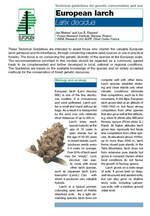Larix decidua - Technical guidelines for genetic conservation and use for European larch
This publication has been translated into the following languages:
Slovenian
The lack of natural regeneration can be favoured at high elevation (e.g. over 1500 m in the Alps), with protection against farm animals, soil scraping and complementary plantation; at lower elevation the competition with shade-tolerant tree species should be controlled by thinning to favour larch growth, flowering, fructification and establishment of seedlings. Protection against game animals is often necessary.
At all elevations, crossing with other European larch populations and species should be avoided by prohibiting their introduction in close contact with native populations. Several national seed transfer regulations have defined provenance regions where only local populations of European larch are recommended for establishment but elsewhere there are no rules preventing the use of alien material except in natural parks or reserves.
European larch requires special management if it is to survive and flourish, especially in mixed forests. For example cutting, in which trees from the upper storey are left as shelter precludes natural regeneration of larch. Thus, the drawing up of general rules of silviculture (felling systems, silvicultural measures, etc.) is necessary to ensure the establishment of progenies from the natural populations of larch and maintenance of larch stands. Assistance to natural regeneration can be provided through weed control, opening of stand canopy, complementary planting and other management efforts.
Japanese and hybrid larches should not be grown near European larch forests that are considered as gene conservation units.
In situ conservation of genetic resources of European larch should be limited to mountain regions and areas where larch is the main forest species.
Ex situ conservation can be carried out through establishment of artificial gene conservation units. These might include plantations as part of breeding programmes, such as clonal archives, clone banks, seed orchards and field trials as well as specifically designed conservation plots. Populations selected for ex situ conservation should be free from genetic ‘pollution’ with other populations of European larch or with other larch taxa.
Larch seed can be stored for at least 30 years in genebanks. Pollen can also be stored ex situ. Cryopreservation of somatic embryogenic lines is another possibility for conservation of larch genetic resources conservation since most technical problems have been solved recently.
Authors: Jan Matras; Luc Pâques
Journal/Series: EUFORGEN Technical Guidelines for Genetic Conservation and Use
Publication Year: 2008
Publication Format: 17x24 Softcover; PDF
ISBN 13: 978-92-9043-788-8
Language: EN
Pages: 6 p.

